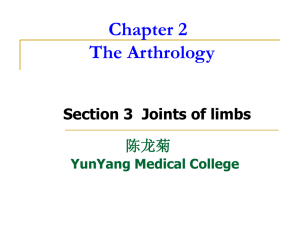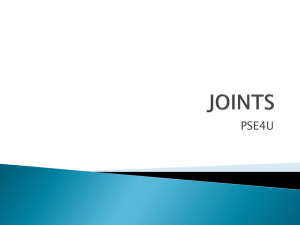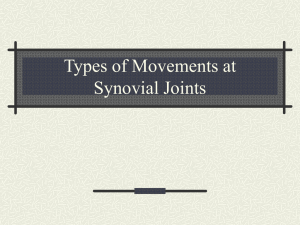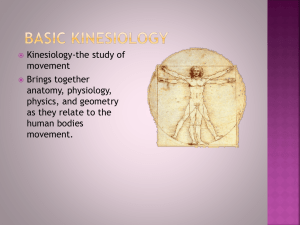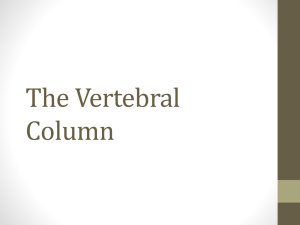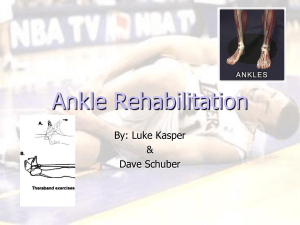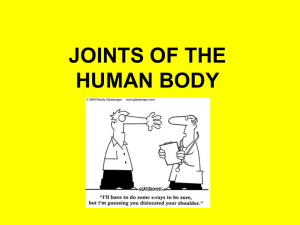PHYT 622
advertisement
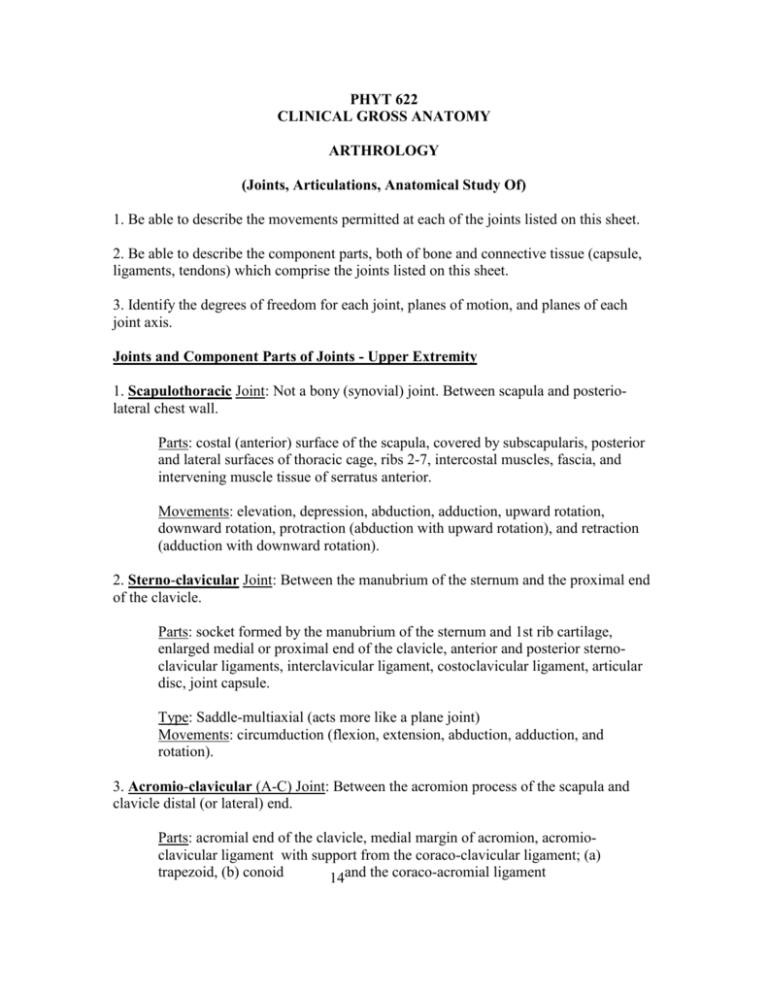
PHYT 622 CLINICAL GROSS ANATOMY ARTHROLOGY (Joints, Articulations, Anatomical Study Of) 1. Be able to describe the movements permitted at each of the joints listed on this sheet. 2. Be able to describe the component parts, both of bone and connective tissue (capsule, ligaments, tendons) which comprise the joints listed on this sheet. 3. Identify the degrees of freedom for each joint, planes of motion, and planes of each joint axis. Joints and Component Parts of Joints - Upper Extremity 1. Scapulothoracic Joint: Not a bony (synovial) joint. Between scapula and posteriolateral chest wall. Parts: costal (anterior) surface of the scapula, covered by subscapularis, posterior and lateral surfaces of thoracic cage, ribs 2-7, intercostal muscles, fascia, and intervening muscle tissue of serratus anterior. Movements: elevation, depression, abduction, adduction, upward rotation, downward rotation, protraction (abduction with upward rotation), and retraction (adduction with downward rotation). 2. Sterno-clavicular Joint: Between the manubrium of the sternum and the proximal end of the clavicle. Parts: socket formed by the manubrium of the sternum and 1st rib cartilage, enlarged medial or proximal end of the clavicle, anterior and posterior sternoclavicular ligaments, interclavicular ligament, costoclavicular ligament, articular disc, joint capsule. Type: Saddle-multiaxial (acts more like a plane joint) Movements: circumduction (flexion, extension, abduction, adduction, and rotation). 3. Acromio-clavicular (A-C) Joint: Between the acromion process of the scapula and clavicle distal (or lateral) end. Parts: acromial end of the clavicle, medial margin of acromion, acromioclavicular ligament with support from the coraco-clavicular ligament; (a) trapezoid, (b) conoid 14and the coraco-acromial ligament Type: Gliding (plane)-multiaxial Movements: All in limited degrees. 4. Coraco-clavicular Joint: A fibrous (non-moveable union) joint connecting coracoid process of scapula and acromion. Connect by the coraco-clavicular ligament consisting of two parts (a) trapezoid and (b) conoid. 5. Coraco-Acromial Joint: A fibrous joint connecting the coracoid process of the scapula with the acromion of the scapula. Connected by the coraco-acromial ligament. 6. Gleno-humeral Joint: Between the glenoid fossa of the scapula and the head of the humerus. Parts: Glenoid fossa, glenoid labrum, weak gleno-humeral ligaments, strong coraco-humeral ligament, joint capsule, tendons of subscapularis, supraspinatus, and the tendon of the long head of the biceps brachii. Type: Ball in socket-multiaxial Movements: All 7. Elbow Joint: (Humero-ulnar and Humero-radial) Articulation of humerus with ulna and radius. AKA "true" elbow. Parts: Trochlea, capitulum, and olecranon fossa of humerus, olecranon process and trochlea of ulna, fovea of the head of the radius, ulnar collateral ligament, radial collateral ligament, and annular ligament. Type: Hinge-uniaxial Movements: Flexion and extension 8. Radio-ulnar Joints: (Proximal, middle, and distal) Proximal - Joint between the head of the radius and the radial notch of the ulna. Parts: Head of the radius, radial notch of the ulna, annular ligament, joint capsule. Type: Pivot - uniaxial Movements: Rotation of the head of radius to provide supination and pronation of the forearm/hand. 15 Middle - Union between the middle aspects of body of radius and ulna. Parts: Body of the radius, body of ulna, interosseous membrane. Type: Fibrous Movements: None Distal - Joint between the head of the ulna and ulnar notch of radius. Parts: As above, joint capsule, small articular disc. Type: Pivot - Uniaxial Movements: Rotation of the distal end of the radius. 9. Radio-Carpal Joint: Articulation of the distal end of the radius with the scaphoid, lunate, and triquetrum carpal bones. Parts: Concave elliptical articular surface of the distal end of the radius and articular disc, convex surface created by scaphoid, lunate, and triquetrum carpal bones, palmar and dorsal radiocarpal ligaments, radio-collateral ligament, and joint capsule. Type: Ellipsoid (condyloid) - biaxial Movements: Cicumduction - flexion, extension, abduction, and adduction. Note: No true rotation at this joint. 10. Mid-carpal Joint: Between the proximal and distal row of carpal bones. Parts: Proximal carpal bones (scaphoid, lunate, and triquetrum), distal row of carpal bones (hamate, capitate, trapezoid, and trapezium), intercarpal ligaments, joint capsules. Type: Gliding - multiaxial Movements: All in small degrees. Play a major role in what is perceived as wrist flexion, extension, abduction, and adduction. Works closely with many small intercarpal joints. 16 11. Carpo - metacarpal Joints (2 - 5): Between the metacarpal bones and respective carpal bones. Parts: Digit 2 with trapezoid, 3 with capitate, 4 with capitate and hamate, 5 with hamate, joint capsule, transverse palmar ligaments. Type: Plane or gliding joints (multi-axial) Movements: All in small degrees 12. Carpo-metacarpal Joint (Thumb): Parts: Trapezium, first metacarpal, oblique ligament, joint capsule. Type: Saddle - multiaxial Movements: All 13. Metacarpo-phalngeal (MP) joints Parts: Proximal phalange with respective metacarpal Type: Ellipsoid - biaxial Movements: Flexion, extension, abduction, adduction, (circumduction), passive rotation 14. Interphalangeal Joints: Parts: Adjoining phalanges, collateral ligaments, joint capsule. Type: Hinge Movements: Flexion and extension. Articulations of the vertebral column Two Main Types of Articulations in the Vertebral Column are the Intervertebral Joints (between vertebral bodies) and the Facet Joints (between inferior and superior articular processes. Associated with both types of joints are the Anterior Longitudinal Ligament, the Posterior Longitudinal Ligament, the Supraspinous ligament (Ligamentum Nuchae in the Neck), the Interspinous Ligament, Ligamentum Flavum, and the Intertransversus Ligament (highly developed in 17lumbar region). 1. Intervertebral Joints: Parts: Adjoining vertebral bodies, the non-synovial fibrocartilaginous connection (annulus fibrosus), anterior and posterior longitudinal ligaments. Type: Fibrocartilaginous Movements: All but limited degrees 2. Typical Facet Joints: Parts: Superior articular facet of one vertebrae with inferior articular facet of vertebrae above, joint capsules, supraspinous, interspinous, and intertransversus ligaments. Type: Gliding - Multiaxial Movements: All 3. Atlanto-axial Joint: Parts: concave superior facets of axis, dens of axis, convex inferior facets of atlas, transverse ligament, anterior and posterior atlantoaxial ligaments, ligamentum nuchae, tectorial membrane. Type: Pivot Movements: Rotation 4. Atlanto-occipital Joint: Parts: Two concave superior facets of the atlas, two convex condyles of the occipital bone, same ligaments as in #3 above. Type: Saddle Movements: Mainly limited nodding (flexion/extension) Joints and Component Parts 18 of Joints - Lower Extremity 1. Hip Joint: Between the head of the femur and acetabulum of the pelvis Parts: Head of the femur and acetabulum, articular capsule, acetabular labrum, iliofemoral (Y), pubofemoral, and ischiofemoral ligaments, head ligament, transverse ligament Type: Ball - in - socket - multiaxial Movements: All 2. Knee Joint: Articulation of the femoral condyles with the condyles of tibia, also includes articulation of patella with the femur Parts: Femoral condyles, tibial condyles, with their menisci, posterior surface of patella, articular capsule, popliteal fascia, tibial and fibular collateral ligaments, anterior and posterior cruciate ligaments, transverse ligament, coronary ligaments, medial and lateral retinacula Type: Modified hinge-essentially uniaxial with passive rotary components Movements: Flexion and extension, limited external and internal rotation, gliding of the patella 3. Tibio-Fibular Joint: Proximal, middle, and distal Proximal Parts: Lateral condyle of the tibia, head of the fibula, articular capsule, anterior and posterior ligaments Type: Gliding - multiaxial Movements: All, very small range, mainly passive Middle Parts: Shafts of the tibia and fibula with interosseous membrane Type: Fibrous Movements: None 19 Distal Parts: Medial side of the distal end of the fibula, lateral side of the distal end of the tibia, anterior and posterior Type: Syndemosis Movement: None 4. Talo-Crural: Ankle articulation of tibial and fibular malleoli and the distal end of the tibia with the talus Parts: Medial articular surface of the distal end of the fibula (lateral malleolus), distal end of the tibia, medial malleolus of the tibia, articular capsule, deltoid ligament, anterior and posterior talofibular ligament, and calcaneofibular ligament Type: Hinge – uniaxial Movements: Plantar and dorsiflexion 5. Subtalar Joint: Articulation between the talus and the calcaneus and navicular. Two parts, anterior and posterior, combine to produce inversion and eversion Posterior portion Parts: Posterior facets of talus and the calcaneus Type: Gliding - multiaxial Movements: All, limited range Anterior portion Parts: Head of talus, concave articular facets in calcaneous and navicular bones Type: Gliding - 20multiaxial Movements: All, limited range 6. Transverse Tarsal Joint: (calcaneocuboid and talonavicular). Articulation between the calcaneous and cuboid and the talus with navicular. Combine with intertarsal and tarsometatarsal to produce forefoot abduction and adduction. Ligaments related to subtalar and transverse tarsal; calcaneonavicular, talonavicular, anterior talocalcaneal, posterior talocalcaneal, interosseous talocalcaneal, cervical, bifurcate, long plantar, short plantar, and plantar calcaneonavicular. 21
